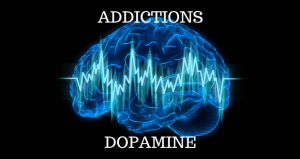How Addictions Train the Body: Dopamine

Addictions are a common place theme in today’s society. If its not a substance addictions, its a relationship. If its not an addictive relationship, its an obsessive pattern of thinking. Our world has allowed an addictive mindset to roam and take greater control. We don’t ingest life anymore, we binge. We overload on TV shows, we feed on sexual addictions and we obsess over things that should not captivate our minds. Too many are being ruled by addicitons. What’s the deal with this?
Brain Chemistry & Dopamine
To understand addictions, you need to understand the basic premise of the brain chemistry that is involved; especially the role of dopamine in the brain. Dopamine is a neurotransmitter that when released in the brain, gives a tremendous rush of pleasure throughout the body. This was especially created to be experienced in the context of sexual orgasm by a husband and wife. That intense release was designed by God to bless us with an experience of pleasure in the context of covenant marriage.
You can also receive a dopamine release when engaging in any activity where you feel that “rush.” It could be experienced when eating chocolate, working at the office, snorting cocaine, watching pornography, riding a roller coaster or getting attention from that person who is not your spouse.
Non-Evil Things Becoming Evil Addictions
Some addictions involve things that in themselves are not evil, such as working at the office, eating chocolate or riding a roller coaster. Not every activity that people become addicted to is evil to begin with. What becomes dangerous is the connection to that habit, activity or person that now chains them. These activities move from becoming periphery things in our lives into dependencies.
Dopamine rushes are not intended to be experienced all day long or continually. They are meant to be an added bonus to a life already filled with contentment and joy. Those who struggle with how they feel about themselves and their lives will develop a chemical low in their brain. They then look to a dopamine rush to rescue them.
Dopamine rushes are meant to be an added bonus to a life already filled with contentment and joy. But when you don’t have good thoughts and feelings about yourself to begin with, an addictive dopamine rush is called upon.
Self-Hate and Addictions
When someone feels bad about himself or herself, then the calming neurotransmitter, serotonin, is low. When serotonin levels are low, people look for a dopamine rush to fill the need. This is a dangerous trap, no matter what the object of addiction is. Dopamine is released in a similar way for the person doing cocaine, as the person who is addicted to chocolate. Both brains become programmed to look for that heavy rush of pleasure.
When serotonin levels are low, people look for a dopamine rush to fill the need.
The Dopamine “Rush”
Let’s use cocaine addiction to help illustrate the dopamine-rush-bondage people fall into. When a person takes their first hit of cocaine, this particular drug initiates a massive release of dopamine that is felt all over the body. If we were to look at dopamine being something that is kept in a storage tank; during this drug hit, the tank is emptied, all the way down to the reserves. The person experiences an extraordinary “high” and “euphoric” experience that has never been experienced before.
It never ends there. No person who uses cocaine does so once and then walks away. They are imbedded with the memory of that rush and seek to get that hit again. They have now drained their dopamine resources, however, and returning again to get that same high that was experienced before. The problem is, the same high he experienced before cannot be reached again, because in that first hit, he had an over the top dopamine release. The following drug hits cannot match it, so the person then becomes bound to chasing that high continually. This is chased through more frequent uses or an elevation in the potency of the drug, usually moving to crack cocaine or heroin.
It has been said that once a person has that initial “over-release” of dopamine, it takes about two years for proper dopamine levels to return to normal, providing the person never uses again. This is why it takes a great deal of commitment and time to walk free from addictions. True deliverance from addictions cannot be achieved overnight. It takes two to three years to confirm that a person has truly been able to untangle themselves from the bonds of addictions. This is not to discourage, but to give a proper understanding and timetable for the “walk-out.” This also shows us what is at stake when the enemy gets someone deeply entangled in the web of addictions.
Like This Article? Subscribe and Never Miss a Post!
Comments: How Addictions Train the Body: Dopamine.
Comments policy




